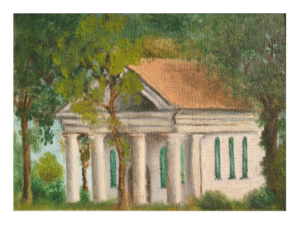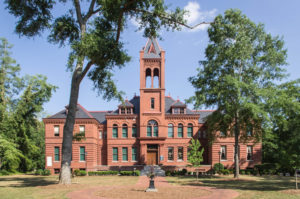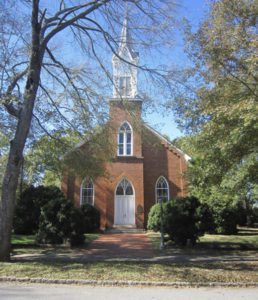Church of the Advent History
Episcopalians came to Morgan County during the early years of the settlement of the county. At first, they met in private homes or traveled to other towns for worship services.

In 1846, a group of Episcopalians gathered to establish the first formal congregation of this denomination in Morgan County and the following year were admitted to the Diocese of Georgia as a parish church. George S. Jessup and Isham V. Fannin were appointed the first wardens. The first Vestrymen were Joshua Hill, Thomas A. Burke. Benjamin G. Liddon. Henry Norton, A. C. Hunt, William H. Burr, Cyrus Morehouse, and Eugene U. Harris. The Reverend Dr. Colley came as rector in 1848 and was followed by the Reverend Mr. Habersham.
During the early 1850s, a Greek Revival-style church building was erected off Academy Street in what is now the main entrance to the old Madison Cemetery. It was called Church of the Advent and was built on a lot deeded to the Episcopal Church by the trustees of the Madison Male Academy. There is a painting of this building in the parlor of the Barnett Parish House.
On August 7, 1853, the Rt. Rev. Stephen Elliott, Bishop of the Diocese of Georgia, came to Madison for consecration of the church building. Records show that the church grew and prospered, especially during the years of Bishops Beckwith and Nelson, and many persons were confirmed.
During the Civil War, Advent Vestryman Joshua Hill, a U.S. senator and mayor of Madison, is credited with negotiating the terms with Gen. Sherman to spare Madison from the scorched earth policy of the Union.
The Great Depression, combined with the plight of the boll weevil brought vast hardship to Madison and Morgan County, causing many to leave the area in search of work and stability. These events weakened the church as well, and in 1937, the church was ordered deconsecrated by Bishop Mikell. The Rev. David Cady Wright, Jr., of Athens, at Bishop Mikell’s direction, came to Madison for the deconsecrating. The contents of the building were given to Emanuel Church in Athens or placed in the hands of members. The building and grounds were sold to the City of Madison for $250; the building was subsequently razed and the property was sold by the city for cemetery lots. Members of the congregation donated the $250 to Appleton Church Home in Macon.
Even when the church was not a physical entity in Madison, the yearning for Episcopal worship never left the county. In 1953, a group of loyal Episcopalians met to reestablish the congregation and invited Bishop Randolph Claiborne and the Reverend Canon Henry Albert Zinser of Church of the Good Shepherd, Covington, to Madison to aid in the project. Canon Zinser was appointed vicar and the congregation was renamed St. Michael and All Angels. (The name was later changed back to Church of the Advent.)

The congregation met first at City Hall in Madison, then reconstructed a building at Madison Graded School (now the Madison-Morgan Cultural Center) for use. The congregation grew during those early years and members began to think again of finding a permanent church home.

In 1961 members, utilizing a cash gift of $7,000 from Sue Reid Walton Manley, purchased the former Methodist Church building on Academy Street from members of the Christian Science congregation. Built in 1844, the building had been slightly altered following a fire in the 1870s. It had fallen into poor repair in the 1950s and required extensive renovation which was undertaken under the leadership of Henry D. Green, W. Graham Ponder, and members of the Vestry with Thomas Little, architect. The church was partially modeled after the Bruton Parish Episcopal Church in Williamsburg, VA. The Reverend David Wright, who had deconsecrated the original church, came from Birmingham and advised on the layout of the floor plan. The interior was redesigned to complement a center aisle. New pews, altar, lectern, and other appointments were purchased. The chandeliers are antique and predate the building. Altar rails and the balcony were kept intact. The reredos was built and designed for the altar, and to make a sacristy and other needed space in the church building. The rear entrance was added at that time.
On February 10, 1963, Bishop Claiborne came to Madison for the consecration of the church building. The Reverend Mr. Wright returned and preached the sermon at the consecration.
In 1992, a new copper roof was added and the steeple completely restored. The following year a balcony was added to the nave and the entire building was renovated. Pews and all other furniture were refinished.
The church is a fine example of Gothic Revival style church architecture from the early 19th century. The narthex (first space beyond the front entry doors) is original except for the 1992 addition of the second stairway (on the right as you enter the building). Beyond the narthex is the nave, with its sloped floor designed for the worship pattern of the Methodists who built the church (for the Episcopalians who kneel for prayers, the slope offers some challenges ameliorated by the use of cushions). The space was originally furnished with Gothic Revival style pews. The present sanctuary is forward of where the Methodist altar was located since the Episcopalians, in the 1961 remodeling, added the platform for the chancel, and beyond the rail, the sanctuary for the altar and cross. Also added in the 1961 remodeling are the paneled reredos separating the chancel and sanctuary from the sacristy, a space that was created to serve the worship pattern and needs of the Episcopal liturgy. The Methodist worship space would thus have had three more windows illuminating the space, one of which would have been in the rear center wall behind their altar. At some point in time, amber colored glass filled the windows.
After the church was deconsecrated by the Methodists, (they moved in 1912 to their present sanctuary on North Main street), a new owner proposed turning the church into apartments, and had plans drawn up by Leila Ross Wilburn, Georgia’s first woman architect. The onset of the agricultural depression that hit this region after World War I ended those plans. The church remained vacant until occupied and used for worship by a local congregation of Christian Scientists. The Episcopalians dedicated the church for use on February 10, 1963.